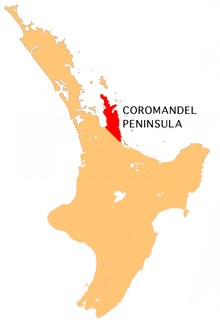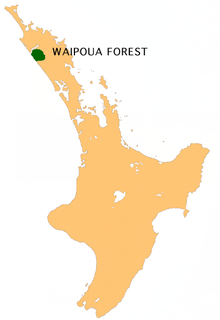
The Square Kauri is an estimated 1,200 year old kauri tree (Agathis australis) in the Coromandel Range on the Coromandel Peninsula, New Zealand. It is the 15th largest kauri on the peninsula [1]

Agathis australis, commonly known by its Māori name kauri, is a coniferous tree of Araucariaceae in the genus Agathis, found north of 38°S in the northern districts of New Zealand's North Island.

The Coromandel Range is a ridge of rugged hills running the length of the Coromandel Peninsula in the North Island of New Zealand. It is located 60 kilometres (37 mi) east of the city of Auckland, and runs north-south for approximately 85 kilometres. The highest point in the range is Mount Moehau, at the northern end of the peninsula within the Moehau Range. There are numerous peaks over 600 metres in height.

The Coromandel Peninsula on the North Island of New Zealand extends 85 kilometres north from the western end of the Bay of Plenty, forming a natural barrier to protect the Hauraki Gulf and the Firth of Thames in the west from the Pacific Ocean to the east. It is 40 kilometres wide at its broadest point. Almost the entire population lies on the narrow coastal strips fronting the Hauraki Gulf and the Bay of Plenty. In clear weather the peninsula is clearly visible from Auckland, the country's biggest city, which lies on the far shore of the Hauraki Gulf, 55 kilometres to the west. The peninsula is part of the local government areas of Thames-Coromandel District and the Waikato Region and is part of the Regional Tourism Organisation representing The Coromandel.
The Square Kauri is a popular stop along the "Tapu-Coroglen Road", as it is only a short walk from the road. Its unusual square-looking trunk spared it from felling when most of the large kauri trees in the area were logged during the late 19th century.

Tapu is a locality on the western side of the Coromandel Peninsula of New Zealand. State Highway 25 runs through it. Coromandel is 35 km to the north, and Thames is 19 km to the south. The Tapu River flows from the Coromandel Range past the settlement and into the Firth of Thames to the west.

Coroglen is a locality in the Coromandel Peninsula, New Zealand. It lies on State Highway 25, 18 kilometres south of Whitianga and 26 kilometres north west of Tairua. The "Tapu-Coroglen Road", a windy gravel road, connects it across the Coromandel Range with Tapu on the west coast of the peninsula.

In botany, the trunk is the stem and main wooden axis of a tree, which is an important feature in tree identification, and which often differs markedly from the bottom of the trunk to the top, depending on the species. The trunk is the most important part of the tree for timber production.










